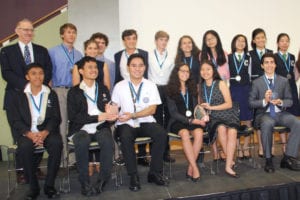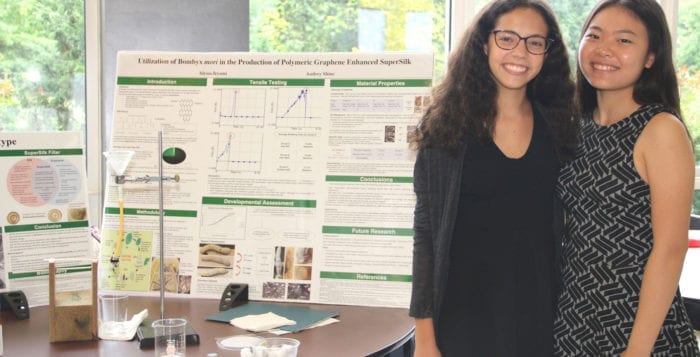Stony Brook University was bursting with “clean” and “green” alternatives July 14 thanks to high school students competing in the international Spellman High Voltage Electronics Clean Tech Contest, a competition geared to challenging teenagers to identify and create solutions to environmental and green building problems.
Now in its sixth year, July 14 was the first time the international competition took place on Long Island. It was hosted by the Center for Science Teaching and Learning of Rockville Centre, which encourages children to learn about science, technology, engineering and mathematics.
The nine teams on hand — which included seven from the United States, one from Singapore and another from the Philippines — competed for the top prize of $10,000. The teams earned their spots in the finals after beating out 230 other teams from around the globe in previous competitions.
This year’s theme was Creating a Greener Future, and the contestants outlined their findings for solutions in topics such as sustainability, green building, “sick” building syndrome and energy efficiency.
In the end, two Plainview-Old Bethpage John F. Kennedy High School students, Alyssa Iryami, 15, and Audrey Shine, 16, emerged the winners with their SuperSilk project. Feeding silkworms graphene, an allotrope of carbon, the girls were able to create strong, natural silk to construct low-cost water purification filters.
After the competition Alyssa and Audrey were ecstatic about their win.
“It’s been such a journey,” Audrey said in a statement. “It’s been a long day. It’s been a long year really because we started this in September, and now that we got this far I can’t believe it.”
Audrey said that both of their grandfathers had experience working with silkworms — hers in China and Alyssa’s in Iran.
The girls said it’s important for young people to get involved in creating green solutions. Alyssa said the sooner such solutions are applied the more people can do to protect the future of the planet to prevent “devastation and destruction.”

“Right now the world needs more environmentally friendly options considering that there’s a lot of pollution and water levels rising,” Alyssa said.
Loren Skeist, president of Spellman High Voltage Electronics, a Hauppauge-based company that sponsored the event, said in a statement the company became involved because the competition touches on important issues and topics that are of interest to the business, plus other aspects were attractive to them.
“The manner in which it’s done both in terms of focusing on practical applications that can have a meaningful impact on one of the central issues of our time, and working as teams and then providing the contestants with an opportunity to interact with teams and high schools from other areas around the world, it’s just a wonderful concept,” he said.
Skeist was not a judge at the event, which he said enabled him to interact with the teams more so than the judges were able to. He said he appreciated the students’ enthusiasm, energy and creativity, and the winners’ concept was extraordinary. He said he hoped the competition will encourage the contestants to continue with innovative green projects and support similar activities by others.
“I learned from their presentations,” he said. “And it gets me excited about the opportunities to use technology to address important issues. They made me maybe more aware of issues that I hadn’t even been fully aware of [before], and some that I had been aware of but was not aware that there was this kind of approach to solve.”
Ray Ann Havasy, director of the Center for Science Teaching and Learning of Rockville Centre and Long Island administrator of the competition, said all the team members possessed creativity, which she said most people don’t realize is a big part of science. She said she was pleased with this year’s venue.
“This place has such a reputation for science and technology,” she said in a statement about Stony Brook.
The administrator of the competition said she was impressed by the winners’ enthusiasm.
“Something simple as silk combined with something that we know of graphene — I think how excited they were that something so common can become something so great,” she said.
Havasy said she hoped students such as the ones involved in the competition will inspire other young people to become involved in STEM education and work on green projects.
“The earth is changing and we need to save it,” she said. “I hate to sound pessimistic but if we don’t believe we can save it, it’s going to keep going the way it is.”





